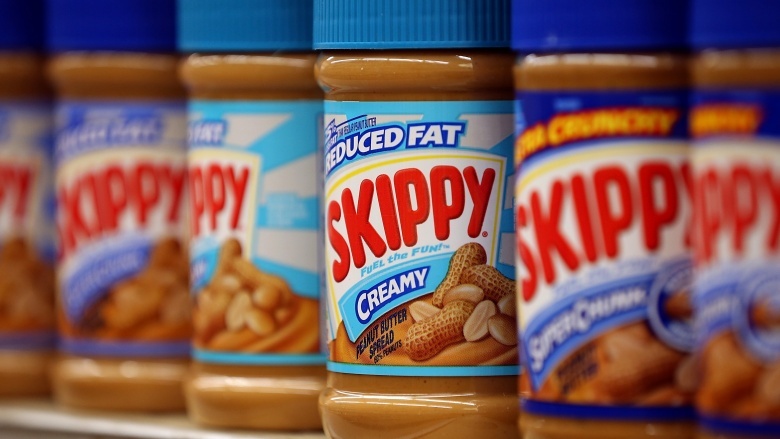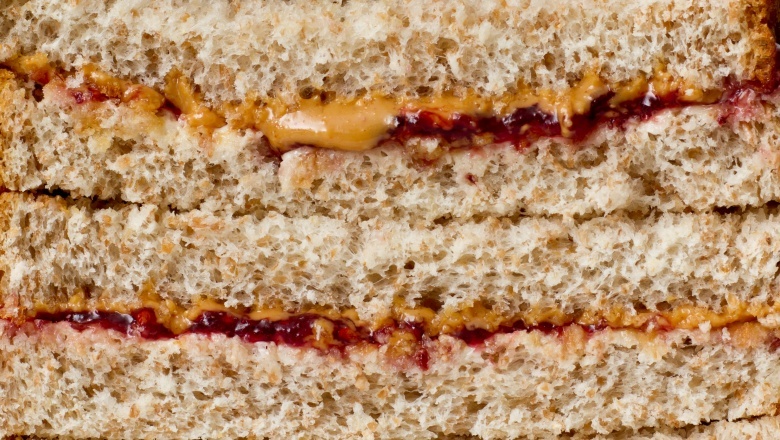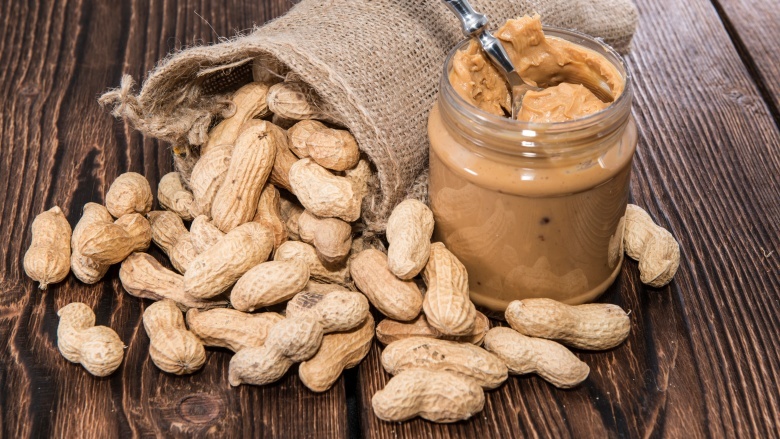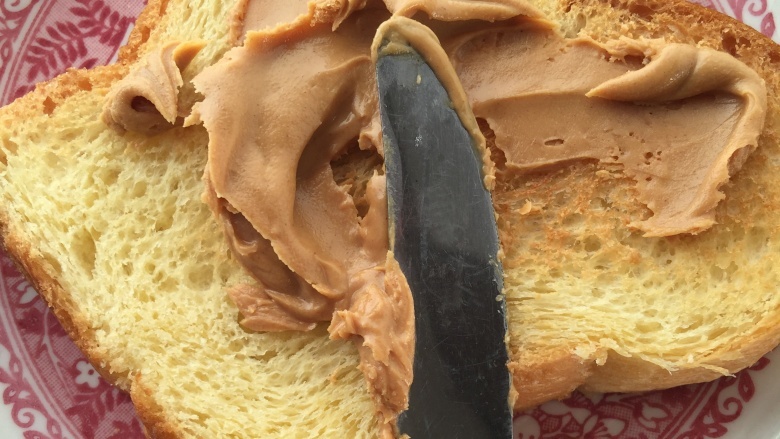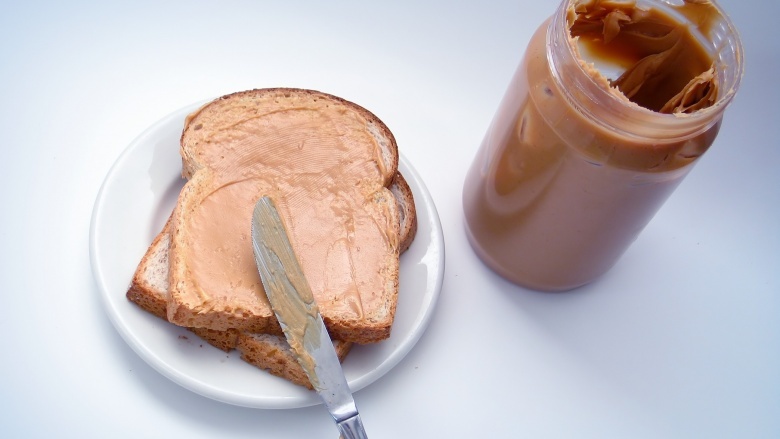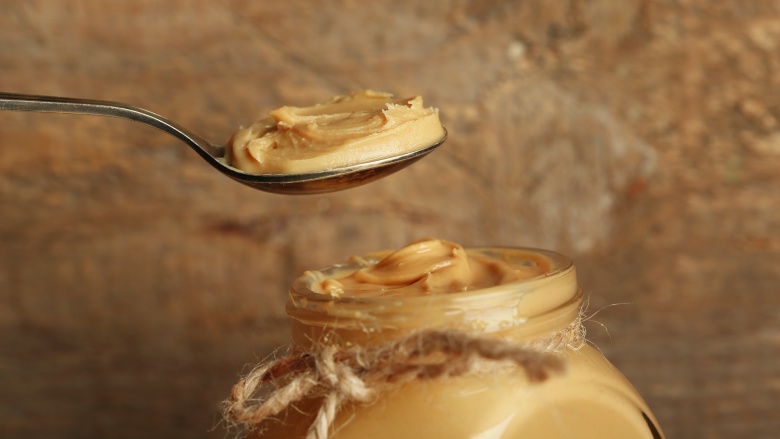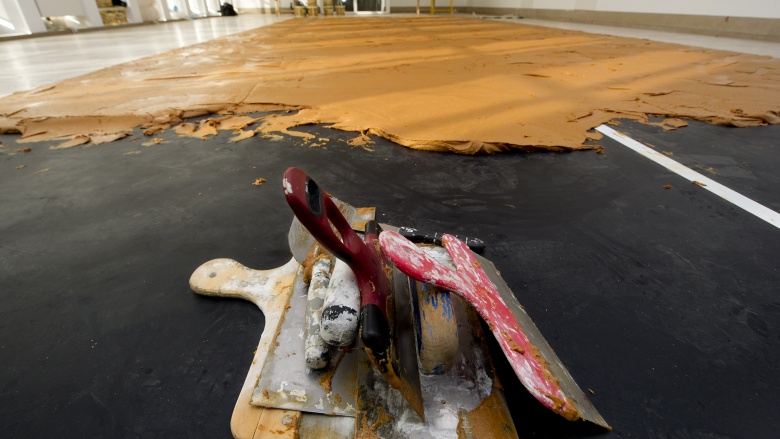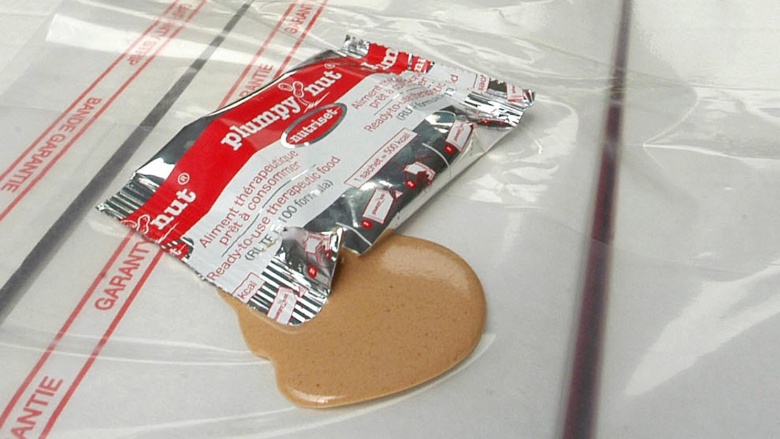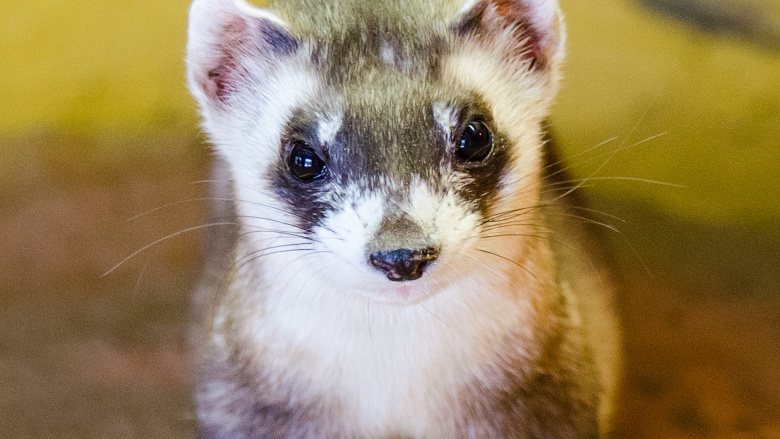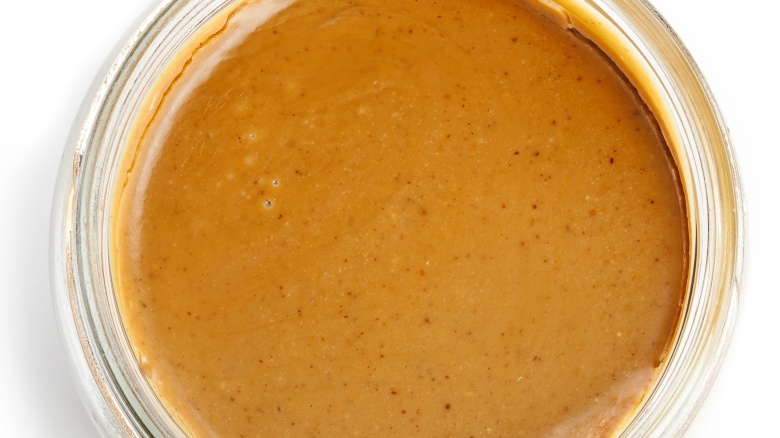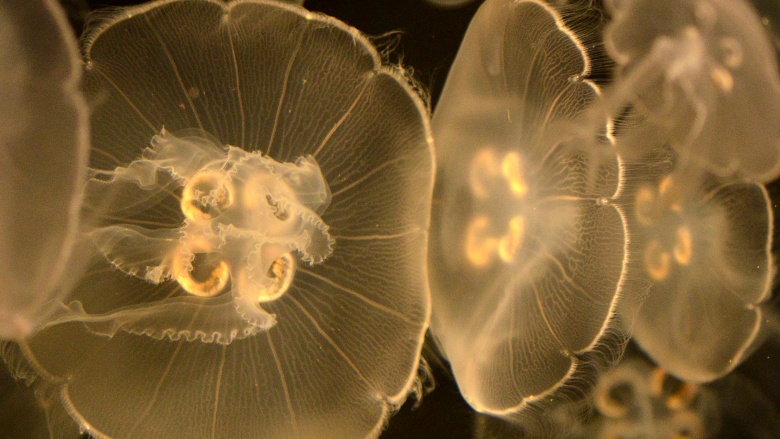Mind-Blowing Facts And Stories About Peanut Butter
With an estimated 90 percent of American homes containing peanut butter, you'd think the sticky, nutty stuff would have precious few secrets left, but you'd be wrong. Here are a few things you probably didn't know about peanut butter.
A lunch regular
It's impossible to talk about peanut butter and not mention jelly, because it's in partnership with that fruity goop that peanut butter is most famously remembered. Peanut butter and jelly sandwiches have been an American lunch favorite since World War II, and nowhere more so than in the lunch bags of school children. In fact, despite how there's no such thing as an average person (only special snowflakes, according to every motivational speaker ever), a mathematically average person would consume 3000 PB&J's in their lifetime. Then consider that some people won't even touch the stuff (because we're talking real life, not averages), and you realize some people are probably inflicting peanut butter breath on their poor buddies seven days a week.
Greater than the sum of its parts
If you ever had dreams of smashing your computer, throwing your phone under a bus, and trading your soulless modern life for a small farm where you can breathe, live simply, and just grow everything you need to survive, then you better not want to eat peanut butter. Because, assuming you won't have any dedicated peanut farming equipment since you'e so anti-technology all of a sudden, you'll have to pick 540 peanuts by hand to make one 12-ounce jar of peanut butter. If you do have the patience for that, however, just a single acre of peanuts would be enough to make 30,000 peanut butter sandwiches, enough to meet the needs of twenty average school age children for a year.
Not just for eating
Peanut butter might be good on sandwiches, in chocolate, in cookies, probably on turkey, or simply spooned straight from the jar, but it also has unexpected non-culinary uses. If you ever find yourself struggling to remove the sticky residue from a label, then peanut butter might just be the solution you didn't know you had! After removing as much of the label as you can, spread peanut butter over the rest and let it sit—about ten minutes later, the residue should easily rub away. Rumors suggest the nutty putty should also help when removing gum from hair, but it's probably best to steer clear of that idea. Whether it does or doesn't, it will definitely leave your hair oily and nutty-smelling, and you'll only get away with that if you work on a baseball concession stand.
If peanut butter was a country...
If 90 percent of homes, and 1500 sandwiches a year, aren't amazing enough numbers for you, then here is one that might ... $850 million. That's how much Americans spend each year on peanut butter. That's not just a lot of money—that's more money than the gross domestic product of several small countries! Just think about that—Americans alone spend more money on peanut butter than some entire countries have to spend on everything ... including peanut butter.
Just one (humongous) peanut butter cup
Would you rather have a million peanut butter cups, or just one really big one? Because that's actually an option now, thanks to Nick Monte, owner of the Village Chocolate Shoppe in Bennington, Vermont. In 2013, he made it his mission to create the world's largest peanut butter cup, and he succeeded when he cooked up a 60-inch wide, 230-pound magnificent monster of a confection. While the idea of a peanut butter cup that weighs the same as a full-grown man might have been the dream of a lot of small children, the reality is more likely just the dream of the local dentist. Fortunately, before local children could spend several days consuming the gigantic record breaker, it was sold off in bits to raise money for an anti-violence charity—or at least, the violence that wasn't already prevented by the enormous quantities of food coma-inducing chocolate everyone was eating afterwards.
Not your mother's PB & J recipe
Unfortunately for Monte, when it comes to world records using peanut butter, someone actually has him beat. In 2010, at the Great American Peanut Butter festival in Grand Saline, Texas, the world's largest peanut butter and jelly sandwich was made. Containing almost 500 pounds of peanut butter, over 700 pounds of bread, and not a small dollop of jelly, this epic lunchbox filler ended up weighing 1342 pounds, which would require an equally world-record-size baggie to store it in. However, the whole attempt was done less out of unrivaled love for PB&Js, and more out of rivalry with Oklahoma, since the previous record-setting sandwich was made there, and weighed 950 pounds. Texans like to claim that everything is bigger in Texas, and now, at least in the world of PB&Js, they're not kidding.
The modern version got its start with Kellogg's Battle Creek Sanitarium
Quick, what's the strangest backstory you can think of for the development of modern peanut butter? How about asylums? Yes, it wasn't until Dr. John Kellogg decided that it was going to have an important place in his sanitarium's menu that it was established as a popular, legitimate food in the modern world, though.
Sanitariums were a big deal in the mid-19th century — they were places to go if you could afford to head off to a country home for rest, relaxation, and kooky health treatments. Kellogg's Battle Creek, Michigan sanitarium, which he joined in 1875, was a bit different, with ideas rooted in Seventh Day Adventist beliefs, a vegetarian diet, and plenty of God-fearing. But Kellogg wasn't just an Adventist — he was also a doctor and a surgeon. By the time he set up shop, he was working on creating a head-to-toe-to-soul treatment for his patients, and that included changing their diet.
In 1899, he founded the Sanitas Nut Food Company, which sold "Sanitas" nut butter, possibly the most poorly thought-out name in the history of naming things. It was designed for patients who had trouble chewing solid foods, giving them all the nutritional benefits of legumes in an easy-to-eat form. He started making nut butter for patients and one-time patients (who, if they wanted to continue eating nut butter, could place an order through the mail). It was one of a whole slew of products that was eventually available from the Kellogg's company though, thankfully, the more common name became peanut butter (presumably because of the snickering).
Most of Europe just doesn't get it
America is a wonderful place for several reasons, peanut butter being many of them. Cross the Atlantic, though, and you'll find tracking down even the smallest jar of peanut butter can be a massive challenge. That's because most European countries just don't think of peanut butter as being anything, much less something you'd actually want to eat (possibly because it was once called "nut butter").
As a whole, the US consumes more than a billion pounds of the stuff every year, and that's not entirely surprising. Look at Europe, though, and you're looking at an average of a single tablespoon per year. We think we see the problem here. If that's all you're eating, then clearly, you're crap at making a real PB&J sandwich.
It's not like we haven't tried to sway the Old World, either. We're constantly running ads and trying to sell them on the wonders of peanut butter, but they're just not biting. In 2012, US peanut farmers had a bumper crop that left them with extra peanuts, mainly because Europe had no interest in hopping on the peanut butter bandwagon, and that's a shame, despite how all those extra nuts meant cheaper peanut butter for the Americans.
Nowadays, you can usually find a small jar in most European grocery stores (though you might pay an arm and a leg), and it's definitely not the same smooth, creamy goodness that people in the States enjoy. Example: in the Netherlands, it's called pindakaas, or "peanut cheese," which might explain why it hasn't really taken off there. They barely even look at it as food there: one man spread it on the floor and called it art. Specifically, he called it "Peanut-Butter Platform" and it's ... well ... a platform covered with peanut butter. Why? Who the hell knows.
It might end world hunger and malnutrition
While Europe's turning their collective noses up at America's nut butter, Africa is having a different sort of reaction to it. There, a nutrient-enhanced type of peanut butter called Plumpy'Nut might just change the world, and that's something we never thought we'd be able to say about peanut butter.
As of 2013, around 20 million children worldwide were considered malnourished, and that malnourishment led to the deaths of around a million of them. Getting nutrients to people who live in the most remote corners of the world isn't easy, so it's super-fortumate that Plumpy'Nut checks a lot of boxes. It has a long shelf-life, doesn't need cooking or refrigeration, and it doesn't have to be taken with water. It can be produced in quantities large enough to make a real difference, and just a small amount contains massive quantities of calories and nutrients like calcium, protein and vitamin E.
The peanut paste concoction is the brainchild of a French physician, and in only a handful of years, it's gone from feeding a relatively small number of children during times of famine, to being cranked out en masse from factories across Africa, put right into the hands (and moth) of hundreds of thousands of children.
It might save an entire species of ferret, too
What's better than a PB&J sandwich? We nominate knowing that black-footed ferrets have dodged the extinction bullet at least twice already, and now have a new fighter in their corner: peanut butter.
In 2016, there were only a few hundred black-footed ferrets left in the wild, where they share their homes with their most common prey: the prairie dog. Unfortunately, prairie dogs are vulnerable to the plague, which then spreads to the ferrets when they eat plague-bearing prairie dogs. Both groups can be wiped out with terrifying speed. There's a vaccine, but have you ever tried to catch a prairie-full of ferrets?
Fortunately, the prairie dogs love peanut butter every bit as much as any other good, red-blooded American. Lacing peanut butter pellets with the vaccine and then delivering them via drone strike (because this is, after all, America) has proven to be a pretty successful method of getting the adorable little creatures to take their life-saving medicine. When researchers dropped off the treats in the morning, they were gone within 20 minutes. They also knew exactly who had gotten the treats, because they were colored with blue dye that stained the faces and paws of the prairie dogs that had gobbled them down. Seriously, can you think of a more adorable plan? We don't think so.
It can help confirm (and maybe diagnose) Alzheimer's
Alzheimer's is one of the most heartbreaking things a person can go through, and there's still a lot we don't know about it and how to treat it. What we are doing is making advances step by step, and in 2013 a graduate student from the University of Florida made a connection between the decline in a person's ability to smell, and the development of Alzheimer's.
Jennifer Stamps set up a series of tests in which patients and volunteers were asked to close their eyes and block one nostril, then see how close they needed to get to a pile of peanut butter before they could smell it. The outcome? Patients that had been diagnosed with early-onset Alzheimer's had trouble smelling anything through their left nostril, and the peanut butter had to be about 10 centimeters closer for them to be able to detect the smell. That reflects a change in the temporal lobe (the first part of the brain to be impacted by the disease), and this simple test might turn into a valuable, low-cost diagnostic tool.
So why peanut butter? One reason is simply that it's cheap, and it's something you can get anywhere. It's also got what's called a "pure olfactory" scent, which means that you only smell peanut butter with your nose. It doesn't make your eyes water, it's not a weird sort of pungent and, when you smell it, there's no question that what you're smelling is peanut butter. That, coupled with how everyone knows what peanut butter smells like, makes it perfect to test for the first signs of cognitive dysfunction, with no invasion and no need for any equipment fancier than a ruler and a bucket of Jif.
The most "normal" jar of peanut butter in the world costs $761
If we told you that there's a jar of peanut butter out there that costs $761, you'd probably first say, "That's a staggeringly precise number," and then, "Holy crap, what's it made from, Martian peanuts?" We'd tell you that of course it's staggeringly precise because it was priced by a department of the US government. Also, nope, no space peanut butter here. In fact, it's the most boring peanut butter you could possibly imagine.
This jar of peanut butter is one of the Standard Reference Materials (SRMs) approved by the National Institute of Standards and Technology, or NIST. NIST is responsible for some pretty important stuff in the science world, and it's basically the establishment of standards that allow scientists to make sure they're conducting the same experiments on the same sorts of things, no matter where they are. Their stuff includes a whole variety of products that are so boringly similar, they can be used for things like calibrating sensitive equipment or providing a baseline for results.
The department stocks hundreds of products from crude oil and whale blubber, so ... why peanut butter? One of the uses for the samples is that they can be broken down into their most basic compounds, and that data is fed into various types of computers and lab equipment. That, in turn, gives researchers a standard to compare their own work and products to, and peanut butter happens to be one of the standards for fatty foods. Since the NIST sample is a standard, that makes it one of the most uniformly, across-the-board, bland-and-boring types of peanut butter out there, and we can't help but wonder if anyone has ever made a sandwich out of it by mistake.
Scientists made peanut butter jellyfish, because of course they have
You can't say scientists don't have a sense of humor and frankly, if we were scientists, we'd make peanut butter jellyfish, too. (It even works with the song. Go on. Try it, you know you want to. We did.) There's actually some legitimate science going on here too, which makes this a double-win.
Marine biologists at the Children's Aquarium at Fair Park of Dallas, Texas, were looking to find out what would happen if they took peanut butter and fed it to a crop of baby moon jellyfish. (Before you say that's cruel, there's a precedent, and the high-protein food is often included in food for marine animals.) They wanted to see if the jellyfish would thrive, and they did. They also turned a sort of peanut-buttery color, which is just plain fun.
Plus, in addition to the obvious party icebreaker that is telling people you spend the day making peanut butter jellyfish, there's a practical reason to do it, too. The typical food of the moon jellyfish (shrimp and fish) isn't entirely sustainable. Replacing that diet with one that's equally nutritious, but infinitely more sustainable, would be a huge bonus, and if it could be done with jellyfish, it might work with other types of marine life, too. Everyone's in favor of a more sustainable world on any level, even if that damn song is going to be stuck in our heads for the rest of the year. It'll probably haunt all our dreams, too.
